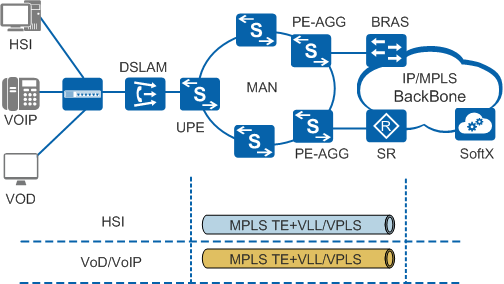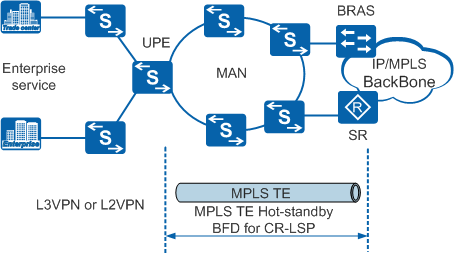MPLS TE Application on an IP MAN
Service Overview
Carriers are converging their service bearer networks. IP/MPLS
technology is essential on these converged networks because the technology
allows voice, video, leased line, and data services to be transmitted
on an IP/MPLS backbone network. Depending upon individual subscribers'
requirements, services on a metropolitan area network (MAN) are classified
into:
- For individual subscribers: high-speed Internet (HSI), video on demand (VoD), and voice over IP (VoIP)
- For business and enterprise subscribers: L3VPN services (business VPN) and L2VPN services (data, video, and voice services)
Table 1 lists
the requirements of these services.
Service |
QoS Requirements |
Reliability Requirements | Security Requirements |
|---|---|---|---|
HSI |
|
|
|
VoD |
|
||
VoIP |
|
||
Business VPN |
|
Networking Description
Feature Deployment
Enterprise or individual services are core services that have
bandwidth, QoS, and reliability requirements. MPLS TE tunnels are
recommended as VPN tunnels on the public network to meet service requirements.
For detailed deployment, see Table 2.
Item |
L3VPN |
L2VPN |
|---|---|---|
Services |
Business VPN |
|
VPN tunnel on the public network |
MPLS TE tunnel |
MPLS TE tunnel |
Reliability |
|
|
QoS |
End-to-end QoS must be configured between a user-end provider edge (UPE) and a broadband remote access server (BRAS) or service router (SR) to ensure service quality. |
|
Security |
RSVP MD5 or keychain is used for authentication. |
|
Key deployment points are as follows: Explicit paths are configured to separately establish primary and backup CR-LSPs. The two paths do not overlap in important areas.

